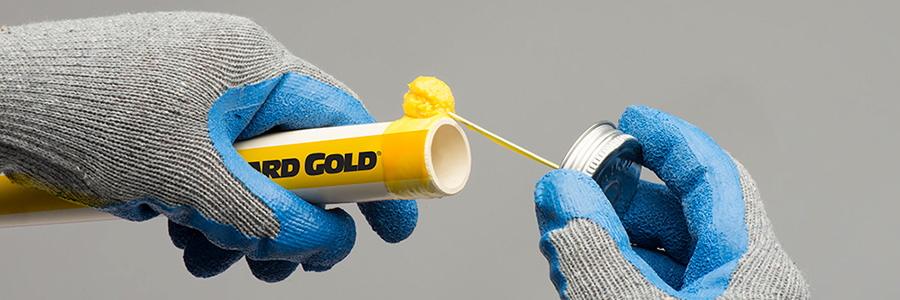
By: Jonathan Simon on November 5th, 2014
Tech Talk: Solvent Welding Best Practices with CPVC
The joining process utilized for all FlowGuard Gold® piping systems requires the proper techniques to ensure a durable and long-lasting system.
Utilizing FlowGuard Gold® Pipe & Fittings brings durability and cost-effectiveness to any plumbing job, and a big part of these benefits is the solvent welding process used to join the pipes and fittings. Solvent welding offers a fast, simple and flexible installation process, but certain considerations need to be taken into account to ensure a proper, effective installation.
Solvent cement
For a long time, solvent welding required a two-step process—primer needed to be applied to the length of pipe, followed by the solvent cement itself. While this process is still followed now when working with very large pipe (including Corzan® Piping Systems), most FlowGuard Gold piping system applications utilize a one-step process—no primer required.
Installers should apply a coat of solvent cement to the pipe itself, followed by a light coating inside the fitting to ensure the right amount of solvent cement is used—installers will want to avoid puddling, which can sometimes seep out into the interior of the pipe itself. The proper sized dauber should be used—common recommendations say a dauber should be half the diameter of the pipe that is being worked with.
Solvent cement interacts with CPVC in such a way that the pipe is fused with the fitting, necessitating another important point.
Bottoming Out
Important when inserting a length of pipe into a fitting is ensuring the pipe bottoms out against the fitting. The more surface area of pipe that contacts the fitting (ideally, the entire surface), the better. This involves making sure the pipe has been cut square, followed by chamfering the pipe end to remove rough bits.
This is all-important because approximately 80 to 90 percent of your joint strength comes from the bottom third of that fitting. This is called an interference fit—if you don’t cut the pipe square, you’re compromising the area that provides strength. As for chamfering, any rough edges and burs that have not been removed can scrape and damage small parts of the pipe when interacting with the solvent cement, which can cause potential pathways for leaks.
Dry fit
Dry fit is simply putting a pipe and fitting together without applying solvent cement. Some installers will do this to ensure proper measurements, or to get an idea of the system before welding it.
It is easy to lose track of which joints may have been dry fitted. FlowGuard Gold piping is strong enough that a pipe and fitting might pass a pressure test even if it has been dry fit, but if a dry fit pipe is missed, it will cause problems later. Welding the system joint by joint is the best practice.
Temperature and humidity
Temperature and humidity levels must be accounted for when working with FlowGuard Gold piping systems and solvent cement. Oatey, a manufacturer of one-step solvent cement commonly used with FlowGuard Gold Pipe & Fittings, notes the temperature range of 40° F – 110° F. Outside of that range, special precautions must be taken.
When working in the cold, Oatey recommends assembling pipe and fittings inside a heated area as much as possible. Solvent cement itself should be stored in a warmer area, such as a work truck or inside the building. Ensure that the cement is warm enough to flow freely—if it is unworkable, avoid use. Primer can be used in these instances to pre-soften the pipe.
Similar precautions should be taken if working under extreme heat—store cement, pipe and fittings in a cooler area if possible. Pipe can be cooled with a damp cloth prior to joining. Primer can be used to facilitate the process in these conditions as well.
By following the proper steps, solvent welding offers an advantageous working process, allowing installers a fast, efficient and cost-effective process.


